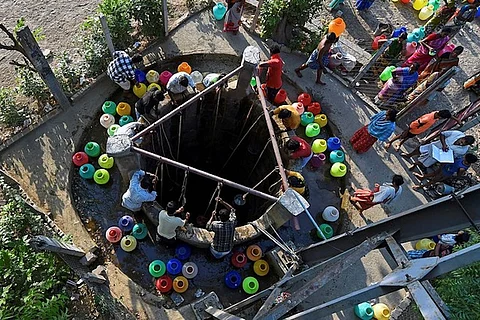

To understand Chennai’s painful relationship with water, it is important to understand water and its relationship to land.
Water that falls from the skies tends to move in two directions: vertically downwards, and laterally down a gradient. The vertical movement is what facilitates groundwater recharge. The lateral movement facilitates drainage. En route its destination to a large water body or the sea, water may encounter depressions where it will gather and stay. Excess water continues to move laterally until it encounters the next water body or joins a larger drain. During its stay in a water body, the water moves upwards (evaporation) and downwards (percolation). The remainder is what we see in a water body. How much water percolates and how much flows away (run-off) depends on the nature of the soil. Sandy soil will soak up the water; run-off will begin only after the sand is saturated. Such areas are great as natural recharge zones. Clayey soils are less permeable than sand; so, when water falls on clayey soils, there is less percolation and more run off. Such soils are also good for location of large surface level storehouses of water. Rainwater percolation pits could be built in such surfaces to facilitate more recharge than would be normally possible due to the clayey nature of the surface soil.
Chennai is currently in the grips of a serious groundwater crisis, which is being worsened by over-exploitation of this resource in this time of crisis. Radical steps are required specifically to replenish, conserve and sustainably harvest groundwater. Open spaces are key to replenishing groundwater.
However, Chennai’s masterplan itself has sanctioned a groundwater disaster by allowing dense construction in areas critical for groundwater recharge.
Slide 1: The tentacle-like formation in Siruseri is a sandy recharge zone where waters from three directions (North, West and South) converge to run east to join the backwaters stretching down to the Kovalam estuary. This natural formation is critical for groundwater recharge in the region. However, this has now been paved over to set up the Siruseri IT Park.
Slide 2: Okkiyam Maduvu, visible as a curving waterbody on the top left corner of the slides drains Pallikaranai marshland into the Buckingham Canal. Here, the Canal itself appears to have been carved out of the marshland that extends to the eastern side of the Canal as well. The eastern marshlands enclosed within the red polygon have all but disappeared under the urban onslaught.
Slide 3: The lands on either side of the Buckingham Canal are fantastic infrastructure. To the west of the Canal, a large unbuilt marshy land is visible with low-lying lands at the bottom left hand corner. This is the convergence point for waters from that region which then flows in a northeasterly direction to the Canal. To the east of the Canal is sandy soil ideal for recharge. Both have been paved over indiscriminately.
Slide 4: The lands surrounding Adyar river near the airport are largely open. Water that falls here will first percolate and then run-off when the land is saturated. The land-use in this region was changed from agriculture (open earth) to paved surface to accommodate a second runway for the Chennai airport.
Slide 5: As you read this, encroachment is ongoing at Kovalam Creek. Watch the space bounded by the black line. A structure that appears to be a road is being constructed across the backwater. The western portion will be filled up and constructed upon.
These are just five reasons why Chennai will be punished by water – desalination plant or no desalination plant.
Nityanand Jayaraman is a Chennai-based writer and social activist